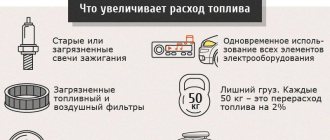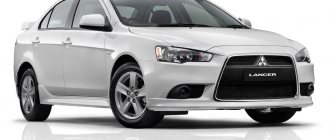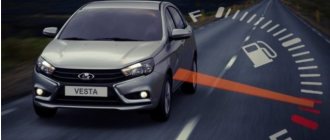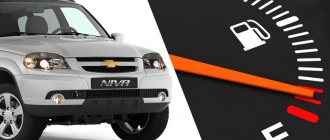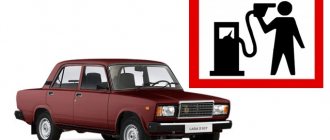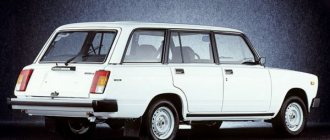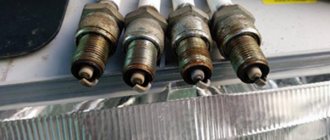- December 23, 2020
- Cars
- Nadezhda Zorina
"Niva-2121" is one of the most famous Soviet and Russian SUVs. This car first appeared in the second half of the 20th century. "Niva-2121" is still being produced. But new models of this SUV are already available with injection engines. Models with carburetor engines can also be found now, but only on the secondary market.
Quite often, many motorists wonder which Niva-2121 is better - with an injector or a carburetor? So, with the Niva injector it is more reliable.
Features of a carburetor car
Before deciding on the choice of a carburetor or injection Niva, it is very important to familiarize yourself with the technical characteristics of both SUV models.
The very first Niva-2121 engine was taken from the Zhiguli. In both the first and second cars, the engine had a large combustion chamber volume, that is, its working volume was 1580 cubic centimeters. Thanks to this engine, it was possible to develop power up to 80 horsepower. And the car could accelerate to 100 km/h in just 20 seconds.
Many novice motorists quite often ask specialists: what is the fuel consumption of the Niva-2121? The carburetor installed on the car affects the difference in fuel consumption compared to a car with an injection engine. Let's consider this nuance in more detail.
For example, judging by the technical data sheet of the car, then 13 liters is the fuel consumption of the Niva-2121. The carburetor, or rather its presence, greatly influences this indicator.
Over time, the engine became more and more modernized. And such an engine began to be numbered 21213. The working volume of the new engine became 1690 cm3, while the power of the power unit amounted to 83 horsepower.
Thanks to the new engine, the car has become more playful. It now takes 18 seconds to accelerate to 100 km/h. It is worth noting that with the introduction of the new engine, fuel consumption has decreased significantly: in contrast to the fuel consumption of the Niva-2121 with a carburetor (1.6 l), it has become less.
For example, if you look at the technical data sheet of an SUV, you will see that the manufacturer claims 11 liters. And as car owners themselves note, this figure is 13 liters.
In winter, the fuel consumption of the Niva-2121 with a carburetor is higher, since at this time it is necessary to warm up the car quite often and for a long time.
Option 2 of 4: Saving fuel
1. When refueling a car, do not fill the tank to the top. It is advisable that it be filled between half and quarter tank. And driving on an empty tank is very harmful to your car. The first thing that suffers is the fuel pump. And keep in mind, a tank filled with 60 liters increases the weight of the car by 45 kg.
2. When changing oil, give preference to synthetic, using additives. This reduces Niva consumption by approximately 15% (subject to the requirements of the instructions). Thanks to additives, the viscosity of the oil is stabilized, making engine operation smoother, because the lubrication process involves the entire volume of oil, and not part of it.
3. When choosing fuel, give preference to the best. Do not mix different types of fuel in one tank. Using cheaper gasoline allows you to save money, and the fact that cheap gasoline contains a large amount of ethanol indicates a significant overconsumption of fuel. As an experiment, you can fill up with the same amount of gas, determine which distance you can cover, and what is generally best for your car.
4. The use of synthetic oils will enable fuel savings of approx. by 5% . You should not ignore the scheduled oil change; this can result in excessive fuel consumption and damage to the engine. If for some reason you cannot use synthetic oil, then purchase the lightest one. For example, 5W-30 will have a greater effect than 15W-50. Watch how the engine behaves while driving. Sometimes engines running on synthetic oil run harder.
5. A significant increase in Niva consumption was noticed when using an air conditioner within the city. However, when driving on the highway in a car with air conditioning, fuel economy will be greater than with the windows open.
The air resistance when driving with the windows open is higher than the power consumed when using the air conditioning.
6. A visual assessment of fuel consumption can be given by knowing how loaded the engine is. Using air conditioning, sudden and frequent increases in speed, and traveling at high speeds have a serious impact on fuel consumption, but these are not the main indicators. Pay attention to engine speed. It's like monitoring your pulse by assessing your heart function.
Features of an injection car
The Volzhsky plant completely switched to injection engines in 2005. These changes affected not only the Niva-2121 SUV, but also many other cars. The new engine received a new number - 21214. The volume of the new gasoline unit began to be 1690 cm3. As for its power, it remained the same, the same as the carburetor - 83 horsepower. The acceleration remained the same, nothing has changed.
The fuel consumption of the Niva-2121 with an injector decreased, in contrast to the carburetor engine, by about 1.5 liters. This is already a big advantage compared to previous Niva models.
As for the average fuel consumption of the Niva-2121 per 100 km, these figures look like this:
- If you drive exclusively on the highway, then 8.3 liters will be spent per 100 km.
- If you drive exclusively around the city, then per 100 km the fuel consumption will be 12 liters.
- And if you drive in mixed mode, 100 km will require 10 liters of gasoline.
These data were obtained under standardized conditions using special measuring equipment.
Today, Niva-2121 is produced with an engine whose index is now 21214-28. The volume of the working engine is now 1774 cm3. The power of the new engine is 92 horsepower. And the SUV began to accelerate a little faster; it could accelerate to 100 km per hour in just 17 seconds. At the same time, fuel consumption does not exceed 10 liters.
Niva gas costs, difference
Propane consumption, savings
| Volume | Transfers | Gas type | Gas consumption by road type | Refueling for 1000 km, mixed mode | ||||
| In the city | On the road | Mixed | Petrol | Gas | Difference | |||
| 1.7 | Mechanics | CIS | 15.4 | 8.8 | 11.0 | 3 742 ₽ | 2 047 ₽ | |
| LPG - liquefied petroleum gas (propane). Gas price in rubles per liter: CIS - 18.61 rubles. | ||||||||
Compressed natural gas is consumed in city mode at the speed of gasoline, and on the highway it is 20% slower. CNG is cheaper than LPG by one and a half to two rubles per liter.
What is a carburetor
If we compare the carburetor Niva and the injection one, we can conclude that the first is more archaic and old. The carburetor is the main component in this system. That is, it is this mechanism that, during operation, mixes air with a portion of gasoline, thereby creating a flammable mixture. The system itself is a simple device. But, despite this, many car owners are not entirely happy with this engine, since quite often it let them down.
A carburetor engine contains: a float, jets, and needles. It is worth noting that all these mechanisms require regular cleaning and regulation.
Disadvantages of the carburetor
The main disadvantages include the following:
- This engine is unreliable. That is, almost every season it is necessary to service the carburetor and adjust it.
- Such a motor is highly dependent on air temperature. Mostly problems arise in winter with such an engine. For example, if you overfill the spark plugs, it will be impossible to start the car. To do this, you will have to unscrew them and dry them. In addition, in winter the float often gets stuck, this is due to condensation. In the summer, many Niva owners with a carburetor engine are faced with such a problem as an overheated fuel pump.
- Low productivity. To increase the engine's potential, it is necessary to spin the engine to high speeds.
- Very high fuel consumption.
It is worth noting that, despite the fact that this power system is quite simple and repairable, it requires special attention. Many car owners should prepare in advance for the fact that they will have to rebuild the carburetor several times every year.
Fuel consumption and temperature
A uniform and smooth driving style helps reduce gasoline consumption. It is not recommended to brake or accelerate the car sharply - the result will be the opposite. Some factors are present only in winter. Thanks to them, the average gasoline consumption on a VAZ 21214 can almost double.
Increased fuel costs are determined by air temperature. The lower the thermometer shows, the higher the gasoline consumption.
This is explained by the fact that the engine, seats, external windows and steering wheel, windshield and rear windows warm up. In addition to this, there are a number of other reasons:
- reduction in tire pressure, which occurs automatically due to low temperature. This entails a narrowing of the tire rubber, resulting in a drop in pressure;
- The condition of the road in winter plays a big role. If there is ice on the road, then when the car starts moving, the wheels are polished and gasoline consumption increases;
- bad weather conditions (snowfall, blizzard) force drivers to reduce their speed, which entails the same high fuel consumption.
What has changed with the arrival of the new engine?
Today, Niva-2121 is produced only with injection engines. New engines began to use distributor injection, with each cylinder having its own injector. If previously all engine elements were mechanical, now they have become electronic. An electronic control unit also appeared in the SUV.
In order for the injection engine to always operate stably, it is necessary that there are sensors for monitoring air, detonation, and throttle position. This device also includes a crankshaft position sensor.
Although the system may seem very complicated, in reality it is not at all like that. The mechanical part of the motor has not become more complicated. In the injection model, instead of a carburetor, injectors and a fuel rail appeared, and as for the throttle valve, it is now located separately. Electronic sensors appeared.
Main advantages of the injector
The advantages of the injection Niva include the following:
- High with an injection engine is much faster compared to previous models.
- The operation of the internal combustion engine is stable. That is, due to the fact that the engine has IAC, many car owners have forgotten what floating speed is. Models with a carburetor engine always have real problems with this.
- Low fuel consumption of the Niva VAZ-2121. With the advent of the injection engine, the car began to consume about 20% less fuel.
- This engine is the most reliable. That is, such a motor does not need regular tuning, cleaning, or replacing jets. The only thing that the owner of a Niva-2121 car may need to do is clean the throttle valve. But this procedure is not mandatory. Experts recommend doing this in situations where the car picks up high speed at idle.
How to reduce gasoline consumption?
There is unlikely to be a noticeable effect:
- From the use of “chemistry” (additives);
- From installing all kinds of “magnets”, etc.;
- Switching to “synthetics” (for example, 5W40) is a radical method, but not recommended;
- From the transition to AI-92, “liter consumption” increases slightly, consumption in rubles decreases.
To improve efficiency, you need to properly configure the transmission. People usually talk about balancing cardans, but know that imbalance can only occur as a result of deformation. There is no need to pay money for an almost useless procedure. However, let the owner make the final choice.
Balancing and correct installation of the RC
Everything is clear with shaft balancing, but other elements are usually not thought about.
Transfer case and two shafts
Make sure you meet the following requirements:
- The transfer case (RK) is installed so that the axis of the gearbox shaft and the primary axis of the RK meet at a point coinciding with the center of the CV joint (see drawing). Also, the steering wheel must be centered: each secondary shaft must be parallel to the bottom and directed strictly along the body.
- The crosspieces should turn easily, and, moreover, with the same force!
- Avoid play in splines, crosspieces and secondary shaft bearings.
The tighter the crosspiece rotates, the more the steering wheel can deviate on its “pillows”. This results in noticeable energy losses.
The crosspieces are located inside the anthers
Subtleties of diagnosis
By looking at the noise spectrum, you can find out what exactly is making noise. Let the rotation speed be N. Then:
- Only one of the crosses can produce a sound with a frequency of 2N;
- The secondary shaft of the RK will make noise with frequency N.
Common problem
Often the knock sensor on the 2123 engine fails. When installing it, it is “tightened” - the tightening torque should be 18 N*m.
You just need to take it and replace the DD. Suitable options:
- 21120-3855020-00, -01, -02, -03;
- Fenox SD10100O7;
- BOSCH 0 261 231 046.
Injector disadvantages
As for the disadvantages, such an engine does not have many of them.
Due to the fact that a lot of electronics have appeared in the engine system, car owners may encounter malfunction of control sensors.
In situations where the SUV begins to consume a large amount of fuel, it is definitely recommended to recheck the mass air flow sensor. And if the engine no longer maintains normal speed at idle, then the IAC may be to blame.
And if the engine refuses to start, then it is quite possible that the contact has come loose from the crankshaft position sensor.
It is worth noting that although such problems do occur, they do not happen that often.
You can diagnose these problems yourself, using the simplest multimeter. To do this, it is enough to measure either the resistance or the contact voltage of any of the sensors.
From this we can conclude that breakdowns in most cases occur due to malfunctions of the electronics. As for the mechanical part, it does not raise any questions.
Option 3 of 4: Driver Habits
1. Use cruise control driving technique. This often helps save fuel while maintaining a constant speed.
2. Don't rush. As the speed increases, the resistance of the oncoming air flow also increases. When driving at higher speeds, fuel consumption increases by up to 30%. At a speed not exceeding 60 km/h, the effect of air resistance on fuel consumption is practically non-existent, and at higher speeds it becomes more significant.
3. Sharp accelerations are very harmful. Internal combustion engines have an optimal operating mode at 2000-3000 rpm, and the greatest power develops at 5000-6000 rpm. When the engine reaches the required speed, you need to switch to the next gear using a manual gearbox.
For example, to accelerate a car to 50 km/h, you turn on the first, accelerate on the second, and then, skipping the third, turn on the fourth or fifth, provided the engine maintains speed. But you need to remember that when you press the gas pedal in fifth gear at low speed, there will be no acceleration. In this case, you can switch to a lower gear .
4. Try to brake as little as possible, because for subsequent acceleration you will use up fuel that could be saved. Carefully monitor the operation of traffic lights to avoid unnecessary acceleration.
5. You should not warm up the car while idling. It is better to do this by starting slowly, avoiding jerky accelerations until the engine reaches the required temperature.
6. Decide on the optimal speed in relation to the amount of fuel consumed. Often this is 80 km/h. Optimal speed involves minimum speed in maximum gear. For example, the optimal speed of Jeep Cherokees is 90 km/h, and Toyota 4Runners is 80 km/h . Determine the optimal speed of your car, try to stick to this speed when traveling.
7. Some cars are equipped with gearboxes that have an “overdrive” function. If your car is one of those equipped with this device, turn it on in a timely manner. In some cases, turning it on is inappropriate, for example, when towing a large load. The “overdrive” function is considered to be turned on by default when the gearbox lever is in the “D” position. In some cars, this function is turned off with a button. But it can turn off when the engine brakes while moving down, or, conversely, when going up. This feature contributes to slight fuel savings by allowing you to maintain speed at low engine speeds.
8. Carefully monitor the operation of traffic lights . Sharp acceleration and braking do not have the best effect on the Niva’s consumption. You shouldn’t circle around the parking lot for a long time, burning fuel, to choose a more convenient place. You have to accept that the most convenient seats are always occupied.
9. Maintaining a safe distance is very important. Driving at a short distance forces you to brake and accelerate much more often than driving 20 meters at the same speed. You will gain time for braking at traffic lights, you will have to brake significantly less in connection with the car in front, and you will also have the opportunity to maneuver.
10. Long-term heating has an adverse effect on Niva consumption. In the cold season, 30 seconds is enough . During this time, the engine is already sufficiently lubricated for safe operation. If you stop for more than 10 seconds, turn it off. This will also help save fuel. But keep in mind that if you start the engine frequently, you will damage the starter.
11. Decide on the gear that is most suitable for uniform movement. When driving lightly on the highway, you can resort to the highest gear. Listen carefully to the operation of the engine, since driving in a high gear is fraught with malfunctions in insufficiently powerful engines. Some manufacturers offer various versions of the gear ratio in the gearbox.

